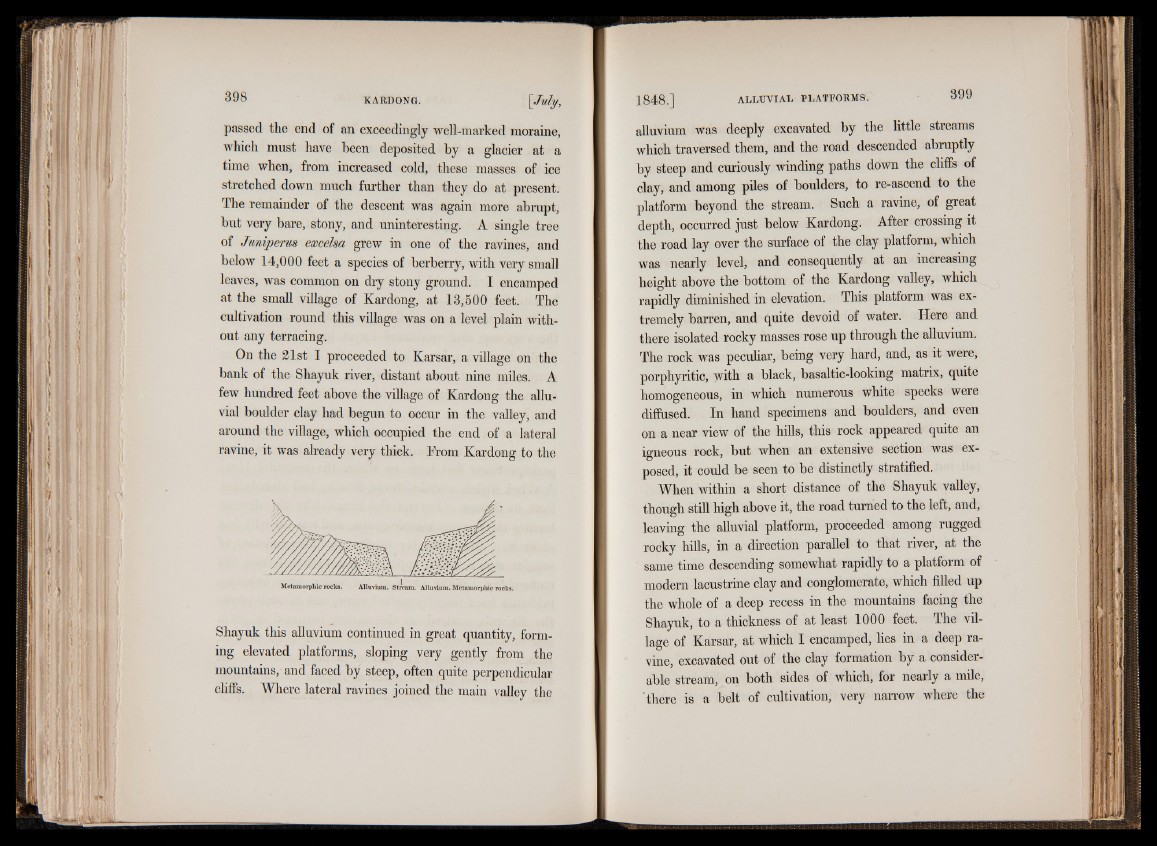
passed the end of an exceedingly well-marked moraine,
which must have been deposited by a glacier at a
time when, from increased cold, these masses of ice
stretched down much further than they do at present.
The remainder of the descent was again more abrupt,
but very bare, stony, and uninteresting. A single tree
of Juniperus excelsa grew in one of the ravines, and
below 14,000 feet a species of berberry, with very small
leaves, was common on dry stony ground. I encamped
at the small village of Kardong, at 13,500 feet. The
cultivation round this village was on a level plain without
any terracing.
On the 21st I proceeded to Karsar, a village on the
bank of the Shayuk river, distant about nine miles. A
few hundred feet above the village of Kardong the alluvial
boulder clay had begun to occur in the valley, and
around the village, which occupied the end of a lateral
ravine, it was already very thick. From Kardong to the
Shayuk this alluvium continued in great quantity, forming
elevated platforms, sloping very gently from the
mountains, and faced by steep, often quite perpendicular
cliffs. Where lateral ravines joined the main valley the
alluvium was deeply excavated by the little streams
which traversed them, and the road descended abruptly
by steep and curiously winding paths down the cliffs of
clay, and among piles of boulders, to re-ascend to the
platform beyond the stream. Such a ravine, of great
depth, occurred just below Kardong. After crossing it
the road lay over the surface of the clay platform, which
was nearly level, and consequently at an increasing
height above the bottom of the Kardong valley, which
rapidly diminished in elevation. This platform was extremely
barren, and quite devoid of water. Here and
there isolated rocky masses rose up through the alluvium.
The rock was peculiar, being very hard, and, as it were,
porphyritic, with a black, basaltic-looking matrix, quite
homogeneous, in which numerous white specks were
diffused. In hand specimens and boulders, and even
on a near view of the hills, this rock appeared quite an
igneous rock, but when an extensive section was exposed,
it could be seen to be distinctly stratified.
When within a short distance of the Shayuk valley,
though still high above it, the road turned to the left, and,
leaving the alluvial platform, proceeded among rugged
rocky hills, in a direction parallel to that river, at the
same time descending somewhat rapidly to a platform of
modern lacustrine clay and conglomerate, which filled up
the whole of a deep recess in the mountains facing the
Shayuk, to a thickness of at least 1000 feet. The village
of Karsar, at which I encamped, lies in a deep ravine,
excavated out of the clay formation by a considerable
stream, on both sides of which, for nearly a mile,
'there is a belt of cultivation, very narrow where the